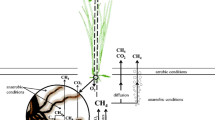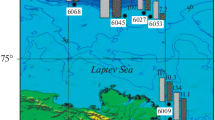Abstract
Methane oxidation by microorganisms inhabiting aerobic soils is a key process involved in the regulation of the concentration of this significant greenhouse gas in the atmosphere; however, the microorganisms responsible for this process remain unknown. Three stable methane-oxidizing cultures were isolated from samples of forest soils (FS) and agricultural soils (AS) of Moscow oblast, as well as from soil samples collected from a Belgian agrocenosis (BS). The obtained enrichment cultures exhibit a high affinity for methane; their km values range from 54.2 to 176.8 nM CH4 and are comparable to those of aerobic soils. Analysis of the fragments of the ribosomal (16S rRNA) and functional (pmoA) genes of methanotrophs by PCR— DGGE and cloning demonstrated the presence of bacteria belonging to the genera Methylocystis in FS, Methylosinus in AS and BS, and Methylocella in BS. It was established that Methylocystis and Methylosinus detected in the enrichment cultures contain the genes encoding the synthesis of the active center of two membrane-bound particulate methane monooxygenases; it is likely that one of these genes (pmoA2) is responsible for the capacity of these microorganisms for oxidation of atmospheric methane.
Similar content being viewed by others
References
Rasmussen, R.A. and Khalil, A.K., Atmospheric Methane (CH4): Trends and Seasonal Cycles, J. Geo-phys. Res., 1981, vol. 86, no. 10, pp. 9826–9832.
Conrad, R., Soil Microorganisms as Controllers of Atmospheric Trace Gases (H2, CO, CH4, N2O and NO), Microbiol. Rev., 1996, vol. 60, pp. 609–640.
Boeckx, P., Van Cleemput, O., and Villarvo, I., Methane Oxidation in Soils with Different Textures and Land Use, Nut. Cyc. Agroecosys, 1997, vol. 49, pp. 91–95.
Chan, A.S.K. and Parkin, T.B., Methane Oxidation and Production Activity in Soils from Natural and Agricultural Ecosystems, J. Environ. Qual., 2001, vol. 30, pp. 1896–1903.
Knief, C., Lipski, A., and Dunfield, P.E., Diversity and Activity of Methanotrophic Bacteria in Different Upland Soils, Appl. Environ. Microbiol., 2003, vol. 69, pp. 6703–6714.
Semenov, V.M., Kravchenko, I.K., Kuznetsova, T.V., Bykova, S.A., Dulov, L.E., Gal’chenko, V.F., Pardini, G., Gispert, M., Boeckx, P., and Van Cleemput, O., Seasonal Dynamics of Atmospheric Methane Oxidation in Gray Forest Soils, Mikrobiologiya, 2004, vol. 73, no. 3, pp. 50–57 [Microbiology (Engl. Transl.), vol. 73, no. 3, pp. 356-362].
King, G.M., Ecological Aspects of Methane Oxidation, a Key Determinant of Global Methane Dynamics, Adv. Microb. Ecol., 1992, vol. 12, pp. 431–468.
Hütch, B.W., Methane Oxidation, Nitrification and Counts of Methanotrophic Bacteria in Soils from a Long-Term Fertilization Experiment (Ewiger Roggenbau at Halle), J. Plant. Nutr. Soil. Sc, 2001, vol. 164, no. 1, pp. 21–28.
Kravchenko, I.K., Semenov, V.M., Kuznetsova, T.V., Bykova, S.A., Dulov, L.E., Gal’chenko, VF, Pardini, G., Gispert, M., Boeckx, P., and Van Cleemput, O., Physicochemical and Biological Factors Affecting Atmospheric Methane Oxidation in Gray Forest Soils, Mikrobiologiya, 2005, vol. 74, no. 2, pp. 255–260 [Microbiology (Engl. Transl.), vol. 74, no. 2, pp. 216-220].
Kolb, S., Knief, C., Dunfield, P.-F., and Conrad, R., Abundance and Activity of Uncultured Methanotrophic Bacteria Involved in the Consumption of Atmospheric Methane in Two Forest Soils, Environ. Microbiol., 2005, vol. 7, pp. 1150–1161.
Heyer, J., Galchenko, V.F., and Dunfield, P.F., Molecular Phylogeny of Type II Methane Oxidizing Bacteria Isolated from Various Environments, Microbiology (UK), 2002, vol. 148, pp. 2831–2846.
Bourne, D.G., McDonald, I.R., and Murrell, J.C., Comparison of pmoA PCR Primers Sets as a Tool for Investigation Methanotrophs Diversity in Three Danish Soils, Appl. Environ. Microbiol., 2001, vol. 67, pp. 3802–3809.
Dedysh, S.N., Khmelenina, V.N., Suzina, N.E., Trot-senko, Y.A., Semrau, J.D., Liesack, W., and Tiedje, J.M., Methylocapsa acidiphila gen. nov., sp. nov., a Novel Methane-Oxidizing and Dinitrogen-Fix-ing Acidophilic Bacterium from Sphagnum Bog, Int. J. Syst. Evol. Microbiol., 2002, vol. 52, pp. 251–261.
Bykova, S., Boeckx, P., Kravchenko, I., Galchenko, V, and Van Cleemput, O., Impact of Fertilization Type and CH4 Concentration on Methane Oxidation and Methanotrophic Diversity in Arable Soils, Biol. Fertil. Soils., 2006, vol. 43, no. 3, pp. 341–348.
Slobodova, N.V., Kolganova, T.V., Bulygina, E.S., Kuznetsov, B.B., Turova, T.P., and Kravchenko, I.K., Comparative Characterization of Methanotrophic Enrichments by Serological and Molecular Methods, Mikrobiologiya, 2006, vol. 75, no. 3, pp. 397–403 [Microbiology (Engl. Transl.), vol. 75, no. 3, pp. 336-342].
Stahl, D.A. and Amann, R., Nucleic Acid Techniques in Bacterial Systematics, in Development and Application of Nucleic Acid Probes, Stakebrandt, E. and Good-fellow, M., Eds., Chichester: Wiley, 1991, pp. 205–248.
Daims, H., Bruhl, A., Amann, R, Schleifer, K.-H., and Wagner, M., The Domain-Specific Probe EUB338 Is Unsufficient for the Detection of All Bacteria: Development of a More Comprehensive Probe Set, Syst. Appl. Microbiol., 1999, vol. 22, pp. 434–444.
Eller, G., Stubner, S., and Frenzel, P., Group-Specific 16S rRNA Targeted Probes for the Detection of Type I and Type II Methanotrophs by Fluorescence in situ Hybridisation, FEMS Microbiol. Letts., 2001, vol. 198, pp. 31–37.
Holmes, A.J., Costello, A., Lidstrom, M.E., and Murrell, G.C., Evidence that Particulate Methane Monooxygenase and Ammonia Monooxygenase may be Evolutionarily Related, FEMS Microbiol. Lett., 1995, vol. 132, pp. 203–208.
Muyzer, G., de Waal, E.C., and Uitterlinde, A.G., Profiling of Complex Microbial Populations by Denaturing Gradient Gel Electrophoresis Analysis of Polymerase Chain Reaction-Amplified Genes Coding for 16S RRNA, Appl. Environ. Microbiol., 1993, vol. 59, pp. 695–700.
Boon, N., De Windt, W., Verstraete, W., and Top, E.M., Evaluation of Nested PCR-DGGE (Denaturing Gradient Gel Electrophoresis) with Group-Specific 16S rRNA Primers for the Analysis of Bacterial Communities from Different Wastewater Treatment Plants, FEMS Microbiol. Ecol., 2002, vol. 39, pp. 101–112.
Dunfield, P.E., Liesack, W., Henckel, T., Knowles, R., and Conrad, R., High-Affinity Methane Oxidation by a Soil Enrichment Culture Containing a Type II Metha-notroph, Appl. Environ. Microbiol., 1999, vol. 65, no. 3, pp. 1009–1014.
Joergensen, I. and Degn, H., Mass Spectrometric Measurements of Methane and Oxygen Utilization by Methanotrophic Bacteria, FEMS Microbiol. Letts., 1981, vol. 64, pp. 331–335.
Gulledge, J. and Schimel, J.P., Low-Concentration Kinetics of Atmospheric Methane Oxidation in Soil and Mechanism of NH4 + Oxidation, Appl. Environ. Microbiol., 1998, vol. 64, pp. 4291–298.
Seghers, D., Top, E.M., Reheul, D., Bulcke, R., Boeckx, P., Verstraete, W., and Siciliano, S., Long-Term Effects of Mineral Versus Organic Fertilizers on Activity and Structure of the Methanotrophic Community in Agriculture Soil, Environ. Microbiol., 2003, vol. 51, pp. 867–877.
Seghers, D., Verthe, K., Reheul, D., Bulcke, R., Siciliano, S.D., Verstraete, W., and Top, E.M., Effect of Long-Term Herbicide Applications on the Bacterial Community Structure and Function in an Agricultural Soil, FEMS Microbiol. Ecol., 2006, vol. 46, no. 2, pp. 139–146.
Dunfield, P.F., Tchawa Yimga, M., Dedysh, S.N., Berger, U., Liesack, W., and Heyer, J., Isolation of a Methylocystis Strain Containing a Novel pmoA-Like Gene, FEMS Microbiol. Ecol., 2002, vol. 41, pp. 17–26.
Baani, M. and Liesack, W., Two Isozymes of Particulate Methane Monooxygenase with Different Methane Oxidation Kinetics Are Found in Methylocystis sp. Strain SC2, Proc Natl. Acad. Sci. USA, 2008, vol. 105, no. 29, pp. 10203–10208.
Tchawa Yimga, M., Dunfield, R.F., Riske R., Heuer J., and Liesask W., Wide Distribution of a Novel pmoA-Like Gene Sopy among Type II Methanotrophs, and its Expression in Methylocystis strain SC2, Appl. Environ. Microbiol., 2003, vol. 69, no. 9, pp. 5593–5602.
Author information
Authors and Affiliations
Corresponding author
Additional information
Original Russian Text © I.K. Kravchenko, A.K. Kizilova, S.A. Bykova, E.V. Men’ko, V.F. Gal’chenko, 2010, published in Mikrobiologiya, 2010, Vol. 79, No. 1, pp. 114–122.
Rights and permissions
About this article
Cite this article
Kravchenko, I.K., Kizilova, A.K., Bykova, S.A. et al. Molecular analysis of high-affinity methane-oxidizing enrichment cultures isolated from a forest biocenosis and agrocenoses. Microbiology 79, 106–114 (2010). https://doi.org/10.1134/S0026261710010145
Received:
Published:
Issue Date:
DOI: https://doi.org/10.1134/S0026261710010145




